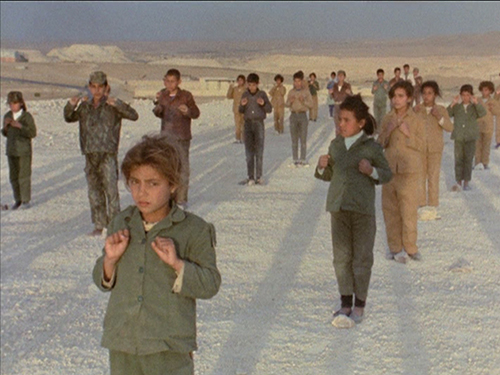
In 1970, Godard and Miéville went to Jordan to shoot footage of Palestinian militants for what was supposed to become a pro-palestinian film for the Palestine Liberation Organization. Soon after, the militants died in the Jordanian civil war and the project was abandoned. Four years later, the filmmakers revisit the footage in Ici et ailleurs. By combining the images shot in Jordan (ailleurs) with images of a French family watching television (ici), Godard and Miéville create a self-critical film that exposes how images work and how the camera often conceals reality instead of revealing it.
"It is not a question of association. Given one image, another image has to be chosen which will induce an interstice between the two. … The fissure has become primary, and as such grows larger. It is not a matter of following a chain of images, even across voids, but of getting out of the chain or the association. Film ceases to be “images in a chain … an uninterrupted chain of images each one the slave of the next”, and whose slave we are … It is the method of BETWEEN, “between two images,” which does away with all cinema of the One. It is the method of AND, “this and then that”, which does away with all the cinema of Being = is. Between two actions, between two affections, between two perceptions, between two visual images, between two sound images, between the sound and the visual: make the indiscernible, that is the frontier, visible. …
Just as the image is itself cut off from the outside world, the out-of-field in turn undergoes a transformation. When cinema became talkie … the sound itself becomes the object of a specific framing which imposes an interstice with the visual framing. The notion of voice-off tends to disappear in favour of a difference between what is seen and what is heard, and this difference is constitutive of the image. There is no more out-of-field. The outside of the image is replaced by the interstice between the two frames in the image … Interstices thus proliferate everything, in the visual image, in the sound image, between the sound image and the visual image. … Thus, in Godard, the interaction of two images engenders or traces a frontier which belongs to neither one nor the other."
Gilles Deleuze1
« En 1968. pour la frange la plus radicalisée – la plus gauchiste – des cinéastes, une chose est sûre : il faut apprendre à sortir de la salle de cinéma (de la cinéphilie, de l'obscurantisme) ou la brancher au moins sur quelque chose d'autre. Et pour apprendre, il faut aller à l'école. Pas tant à l'« école de la vie» qu’au cinéma comme à l’école. C’est ainsi que Godard et Gorin ont transformé le cube scénographique en salle de classe, le dialogue du film en récitation, la voix off en cours magistral, le tournage en travaux dirigés, le sujet du film en intitulés d’UV (le «révisionnisme». I‘« idéologie ») et le cinéaste en maitre d’école, en répétiteur ou en pion. L’école devient donc le bon lieu, celui qui éloigne du cinéma et qui rapproche du « réel » (un réel à transformer s’entend). »
Serge Daney2
“In 1968 stond voor de meest geradicaliseerde – meest linkse – groep cineasten één ding vast: we moeten leren de bioscoopzaal (de obscurantistische cinefilie) te verlaten of hem tenminste aan iets anders koppelen. En om te leren moet je naar school. Niet zozeer naar de ‘school van het leven’ als wel naar de cinema als school. Dus hebben Godard en Gorin de filmkubus veranderd in een klaslokaal, de filmdialoog in een voordracht, de commentaarstem in een hoorcollege, de draaiperiode in een werkcollege, de onderwerpen van films in verplichte studieonderdelen (‘revisionisme’, ‘ideologie’, enz.) en de cineast in een schoolmeester, een studiebegeleider, een mentor. De school wordt dus een goede plek die je van de cinema weghaalt en dichter bij de ‘werkelijkheid’ brengt (een werkelijkheid die moet worden veranderd, dat spreekt voor zich).”
Serge Daney3
“For the most radical fringe of filmmakers - those farthest to the left - one thing is certain in 1968: one must learn how to leave the movie theater (to leave behind cinephilia and obscurantism) or at least to attach it to something else. And to learn, you have to go to school. Less to the "school of life" than to the cinema as school. This is how Godard and Gorin transformed the scenographic cube into a classroom, the dialogue of the film into a recitation, the voiceover into a required course, the shooting of the film into a tutorial, the subject of the film into course headings from the University of Vincennes (“revisionism,” “ideology”) and the filmmaker into a schoolmaster, a drill-master or a monitor. School thus becomes the good place which removes us from cinema and reconciles us with “reality” (a reality to be transformed, naturally.)”
Serge Daney4
- 1Gilles Deleuze, Cinema 2: The Time-Image. Trans. Hugh Tomlinson and Robert Galeta. (London: Athlone, 1989), 179-181.
- 2Serge Daney, “Le thérrorisé (pédagogie godardienne),” Cahiers du Cinéma, 262-263 (1976): 32-40.
- 3Serge Daney, Serge Daney, “Therroriseren (godardiaanse pedagogie)” in Een ruimte om in te bewegen. Serge Daney – tussen cinema en beeldcultuur (Amsterdam: Octavo Publicaties, 2011), 53.
- 4Serge Daney, “The T(h)errorized (Godardian Pedagogy),” translated by Bill Krohn and Charles Cameron Ball.

